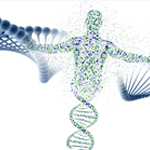Mitochondria are recognized as the powerhouse of the cell since they help convert oxygen and nutrients into adenosine triphosphate (ATP), the energy currency of the cell. Mitochondria are small organelles (usually 0.75~3 micrometers), found in nearly all types of human cells except mature red blood cells, as well as cells of other eukaryotes (such as mammals, plants, fungi and protists). Many of reactions involved in cellular respiration occur in mitochondria, so cells that need more energy contain a larger number of mitochondria. For instance, liver cells can have more than 2,000. It all depends on the metabolic requirements of the cell.
The Structure of Mitochondria
They have two membranes (outer membrane and inner membrane). The outer one allows proteins to cross due to the existence of prions. The inner one is the place where most ATP is generated. The folds of the inner membrane are referred to as cristae, increasing the surface of the inner membrane for more chemical reactions. Within the inner membrane is the matrix where contains hundreds of enzymes for the production of ATP, granules, their own ribosomes and DNA. Many molecular biology methods have been developed to analyze mitochondria. Among them, mitochondrial DNA (mtDNA) sequencing is the most powerful and versatile tool to identify heteroplasmic variants and detect epigenetic modifications.

Figure 1. The illustration of the structure of mitochondria.
The Function of Mitochondria
As mentioned above, the function of mitochondria is to produce energy for cells. The biochemical processes of the cell are called cellular respiration or aerobic respiration. Compared to anaerobic respiration, aerobic respiration can produce a larger amount of energy. This is the reason why higher animals exist as their cells need more ATP. Besides, mitochondria contain calcium for signaling activities, producing heat and mediating cell growth and death. Furthermore, mitochondrial DNA has a relatively high mutation rate, and mitochondria-associated mutations could cause diseases in humans and animals.
Mitochondrial DNA
Similar to the nuclear genome, the mitochondrial genome is double-stranded DNA and encodes genes. It replicates itself independent of the nuclear genome. However, the mitochondrial genome is circular, not enveloped, and not packaged into chromatin. They only contain 37 genes that encode 22 tRNAs, 13 proteins and 2 rRNAs. The small mitochondrial genome is not sufficient to produce all the proteins needed for functionality, thus, the mitochondrion relies heavily on nuclear gene products.
During reproduction, mitochondrial genes are always inherited from the mother, i.e. maternal inheritance. Therefore, a male with a mitochondrial disease is not likely to transmit the disorder to his offspring. Mitochondrial populations are usually heteroplasmic, thus, it is hard to predict disease outcomes. Maternal inheritance makes mtDNA a good vehicle to trace genetic lines. For example, mtDNA analyses have suggested that humans have been suggested in Africa, around 200,000 years ago.
References:
- https://www.nature.com/scitable/topicpage/mtdna-and-mitochondrial-diseases-903/#
- Taylor R W, Turnbull D M. Mitochondrial DNA mutations in human disease. Nature Reviews Genetics, 2005, 6(5): 389.

Leave a Reply